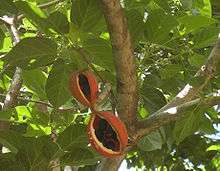Sterculia quadrifida
Sterculia quadrifida, also known as the peanut tree, or red-fruited kurrajong is a small tree that grows in the rainforests, vine thickets, and gallery forests of coastal Queensland, the Northern Territory and north-eastern New South Wales.
| Sterculia quadrifida | |
|---|---|
 | |
| Sterculia quadrifida fruit and foliage. | |
| Scientific classification | |
| Kingdom: | Plantae |
| Clade: | Tracheophytes |
| Clade: | Angiosperms |
| Clade: | Eudicots |
| Clade: | Rosids |
| Order: | Malvales |
| Family: | Malvaceae |
| Genus: | Sterculia |
| Species: | S. quadrifida |
| Binomial name | |
| Sterculia quadrifida | |
The tree grows to a height of 5 –10 metres and has a spreading deciduous canopy. The bark is a light grey and the leaves are dark green and broad egg-shaped or sometimes heart-shaped at the base. The flowers, which are greenish-yellow and are borne in small clusters in the upper axils, occur from November to January (summer in Australia).
Seed pods are orange outside and orange or red inside when ripe. These pods contain up to 8 black seeds that are edible and taste like raw peanuts.[1]
Alternative common names for this species include kuman, orange-fruited kurrajong, orange-fruited sterculia, red-fruited kurrajong, smooth-seeded kurrajong, white crowsfoot and small-flowered kurrajong.
The bark is used by Aboriginal people in their traditional weaving techniques to make baskets and other products.
 S. quadrifida
S. quadrifida S. quadrifida flowers.
S. quadrifida flowers.
References
- Across the Top - Gardening with Australian Plants in the Tropics, Keith Townshend ISBN 0-909830-46-0
- "Sterculia quadrifida R.Br". Australian Plant Name Index (APNI), IBIS database. Centre for Plant Biodiversity Research, Australian Government.